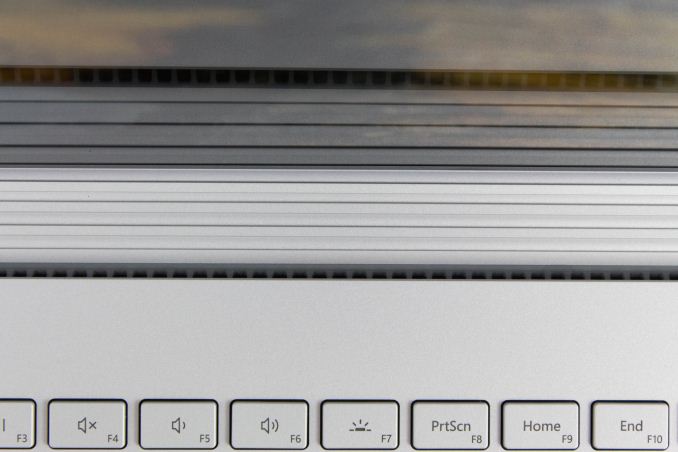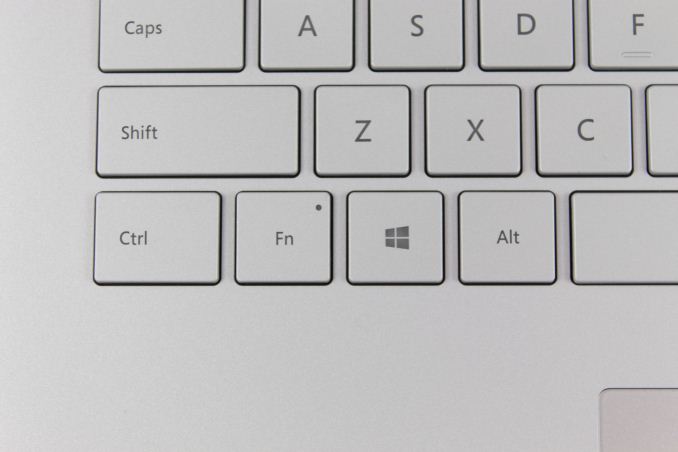The Microsoft Surface Book 2 (15-Inch) Review: Second Time's The Charm
by Brett Howse on December 21, 2017 8:00 AM EST- Posted in
- Laptops
- Microsoft
- Surface
- Pascal
- Surface Book
- Kaby Lake Refresh
Design
When the Surface Book launched, it offered a lot of innovative ideas in the laptop space, and none more innovative than separating the CPU, RAM, and storage into the display section, which is removable, and the GPU and majority of the battery into the base. It allowed Microsoft to pack in more battery than most other laptops at the time. To avoid the usual top-heavy feel of most laptops with a detachable display, Microsoft created an interesting hinge design, which rolls out when opening the display, making the base slightly longer and giving it more leverage. That hinge has returned, and keeps the Surface Book 2 looking like a Surface Book. Not everyone loved the hinge design, but it does work well and gives the Surface Book lineup a design touch that is instantly recognizable. The hinge doesn’t let the display lay flat, but it has to balance the weight of the display versus the requirements of opening the display all the way, which is somewhat negated by being able to detach the display if necessary.
The tablet section is not something you could use as a tablet full-time. At 15-inches in size, it’s a bit unwieldy, which was already an issue with the smaller 13.5-inch model. The squared off edges look great, but don’t help much with in-hand feel of the large tablet. With the relatively small battery capacity, the overall weight of the tablet is light enough that it’s easy to use in short bursts, but short bursts are all you’ll get out of it anyway before the battery needs to be replenished. Just like the original, it offers a satisfying “kerchunk” when detaching from the base.
The base is almost a carbon-copy of the Surface Book with Performance Base mid-cycle upgrade model. The keyboard is slightly raised to give more room for the GPU and cooling components under it. Other than the USB-C port, the new base looks identical to the older version, keeping the two USB-A ports on the left, along with the SD card reader, and offering the Surface Connect port and USB-C on the right.
The keyboard on the original Surface Book was one of the better models available on a laptop, offering good travel, and good key feel. Luckily it hasn’t really changed, and still offers three levels of white backlighting, and thanks to the gray color of the keys, the white backlighting still offers decent contrast even when in a bright environment.
Microsoft offered the best trackpad experience on a Windows PC with the original Surface Book, and that great precision and feel of the glass trackpad carries over with the new model. The trackpad is large, but without being too large, and the latest Precision touchpad software offers plenty of customization for gestures and more. It’s wonderful to use, and makes you miss it when using an inferior device.
Microsoft’s gray magnesium design has become something they are known for, even if not all of the devices are magnesium anymore, but on the Surface Book 2, the texture and feel of the material is as premium as any device on the market. The chassis has a chamfered edge in front of the trackpad to allow you to open it easier, and although the rest of the edges are more acute, they still have a slightly rounded corner to prevent sharp pressure on your wrists when typing. Thanks to the 3:2 aspect ratio of the display, the Surface Book lineup also offers more wrist rest area than most other notebooks.
Overall the design of the Surface Book 2 is fantastic, which is becoming an expectation when dealing with the PC products from Redmond. The only small thing to point out would be the location of the headphone jack, which is on the top right corner of the display, making for a somewhat awkward cable arrangement when using wired headphones. It would be nice to see a second jack in the base, to be used while the laptop is being used as a laptop, but that seems like a small thing to complain about on an otherwise very well designed and built device.













120 Comments
View All Comments
damianrobertjones - Friday, December 22, 2017 - link
Yes... because a 120hz HDR display is essential. Marketing OWNS your soul.The review already states that the screen is, more or less, amazing so adding those two extra features doesn't really do much.
P.s. The iPad Pro, albeit nice, isn't really on the same league (imo).
Frenetic Pony - Friday, December 22, 2017 - link
I have a 120hz desktop screen and is awesome. And I've been waiting on a proper her screen for photo and video editing. Being snide and ignorant gets you nowhere.zogus - Tuesday, December 26, 2017 - link
The iPad Pro's 120Hz display is really, really nice for smooth pen input. It is the first pen UI that didn't make me go back to paper and pencil after a few days.As for not being in the same league, no, of course it's not. I would argue that it doesn't even play in the same sport as the Surface Book.
edzieba - Thursday, December 21, 2017 - link
Damn, that GPU just flat out embarrasses my 'old' Surface Book.Idon'tneedanewlaptopIdon'tneedanewlaptopIdon'tneedanewlaptopIdon'tneedanewlaptop...
tipoo - Thursday, December 21, 2017 - link
That GPU embarrasses the /new/ 15" rMBP top option.Wish for some Nvidia options in there.
bryanlarsen - Thursday, December 21, 2017 - link
This is certainly a much better compromise than the surface. I see lots of Surfaces, but I never see anybody using them in tablet mode. I don't understand why people put up with the Surface's crappy laptop experience when they only rarely use it in tablet mode.The best form factor for most is the Yoga and its clones, IMO. Not a great tablet experience, but it's there, usable and useful, without any compromises on the laptop experience. Optimize for the 99%.
denis.lafronde - Thursday, December 21, 2017 - link
Well, maybe that's because you don't follow those people everywhere :P. I was using my SP3 in tablet mode at my hold job, but now I'm still using it in tablet at home, for watching videos or surfing the internet. It's much less cumbersome than others 2-in-1 when you move it around the house and don't really need a keyboard. If someone needs a laptop, just buy a laptop (or a something like the Yoga), but there is still a lot of people who want a productivity tablet with the occasional keyboards sessions. And the type cover is not THAT bad. Lots of entry level laptops have way worst keyboards.PeachNCream - Thursday, December 21, 2017 - link
The reality is that Windows as an OS and the workload we expect it to perform is still keyboard-centric. People with a Windows tablet end up using some sort of keyboard for a significant portion of their time. Maybe it would make more sense to have a Surface Book or some other convertible computer, but people usually buy things with their hearts first and their minds second. They then justify the thing they bought by changing how they work or citing corner cases. That's just part of what it means to be a human.mkozakewich - Thursday, December 21, 2017 - link
I like to point out that the Surface Pro is *always* in tablet mode. It's a laptop-like tablet where the keyboard is an accessory. More compromise, but it is what it is. The Surface Book, on the other hand, is a convertible laptop. You have to consciously convert it from one mode to the other.damianrobertjones - Friday, December 22, 2017 - link
I typed an entire novel, 68,000 words, on a Surface Pro 3 while travelling around Europe. No issues with it sitting on my lap.